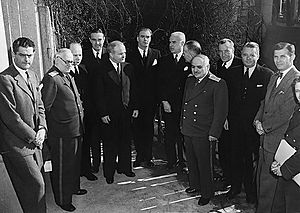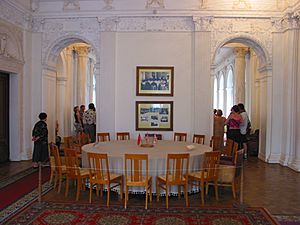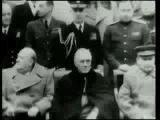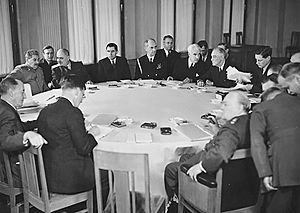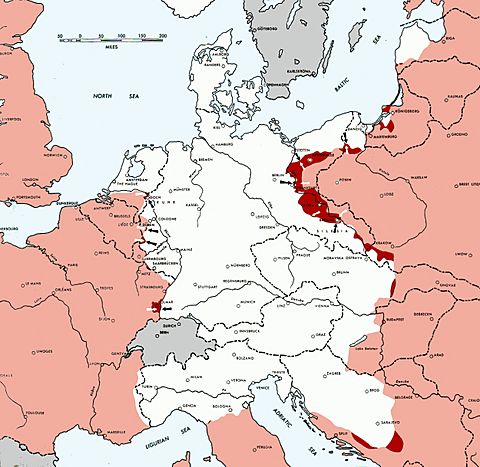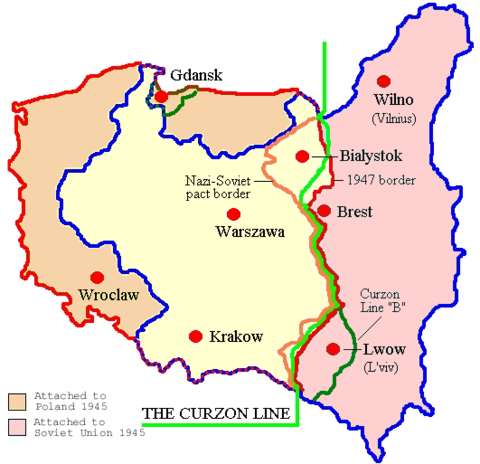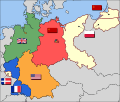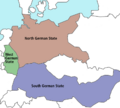Yalta Conference facts for kids
Quick facts for kids Yalta ConferenceCrimean Conference |
|
|---|---|
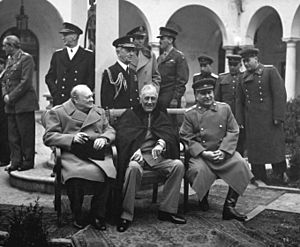
The "Big Three" at the Yalta Conference, Winston Churchill, Franklin D. Roosevelt and Joseph Stalin. Behind them stand, from the left, Field Marshal Sir Alan Brooke, Fleet Admiral Ernest King, Fleet Admiral William D. Leahy, General of the Army George Marshall, Major General Laurence S. Kuter, General Aleksei Antonov, Vice Admiral Stepan Kucherov, and Admiral of the Fleet Nikolay Kuznetsov.
|
|
| Host country | |
| Date | 4–11 February 1945 |
| Venue(s) | Livadia Palace |
| Cities | Yalta, Crimean ASSR, Russian SFSR, Soviet Union |
| Participants | |
| Follows | Tehran Conference |
| Precedes | Potsdam Conference |
The Yalta Conference was a very important meeting during World War II. It happened from February 4 to 11, 1945. The leaders of the United States, the United Kingdom, and the Soviet Union met to talk about what would happen to Germany and Europe after the war.
The three main leaders were:
- Franklin D. Roosevelt, the President of the United States.
- Winston Churchill, the Prime Minister of the United Kingdom.
- Joseph Stalin, the leader of the Soviet Union.
They met near Yalta in Crimea, which was part of the Soviet Union. The meetings took place in grand palaces like Livadia Palace, Yusupov Palace, and Vorontsov Palace. The main goal was to plan for peace after the war.
Yalta was the second of three big meetings between these "Big Three" leaders during the war. The first was the Tehran Conference in November 1943. The third was the Potsdam Conference in July 1945. There was also a meeting in Moscow in October 1944, where Churchill and Stalin discussed their areas of influence in Europe. Roosevelt did not attend that one.
Contents
Planning Europe's Future
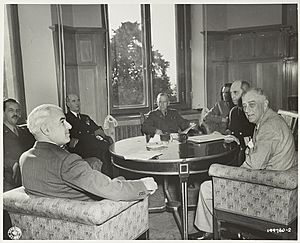
By the time of the Yalta Conference, the Allies were winning the war. Western Allies had freed France and Belgium. They were fighting on Germany's western border. In the east, Soviet forces were only about 65 kilometers (40 miles) from Berlin. They had already pushed German forces out of Poland, Romania, and Bulgaria. It was clear that Germany would be defeated. The big question was what Europe would look like after the war.
The French leader, General Charles de Gaulle, was not invited to the Yalta or Potsdam Conferences. This upset him greatly. Roosevelt and Stalin did not want him to be a full participant.
President Roosevelt wanted this "Big Three" meeting to happen. He hoped for it before the US presidential elections in November 1944. But it was set for early 1945. Roosevelt suggested a neutral place in the Mediterranean. Places like Malta, Cyprus, and Sicily were suggested. However, Stalin said his doctors did not want him to travel far. He suggested Yalta, a resort on the Black Sea in Crimea. Stalin also did not like flying, which helped with this decision.
Leaders' Goals
Each of the three leaders had different goals for Germany and Europe after the war.
Roosevelt's Goals
President Roosevelt wanted the Soviet Union to help in the Pacific War against Japan. He hoped this would end the war faster and save American lives. He also wanted the Soviet Union to join the new United Nations organization.
Churchill's Goals
Prime Minister Churchill wanted free elections and democratic governments in Central and Eastern Europe. He was especially concerned about Poland.
Stalin's Goals
Joseph Stalin wanted the Soviet Union to have a strong political influence in Eastern and Central Europe. He saw this as vital for Soviet national security. He felt very strong at the conference and believed he could set the terms.
Poland's Future
Poland was a key topic for Stalin. He said Poland was a matter of "honor" and "security" for the Soviet government. This was because Poland had often been a path for invaders into Russia. Stalin also said that because Russians had "sinned greatly against Poland" in the past, the Soviet government wanted to make up for it. He insisted that Poland "must be strong" and "free and independent."
Stalin stated that the demands of the Polish government-in-exile were not open for discussion. He said the Soviets would keep the eastern Polish territory they had taken in 1939. Poland would get land from Germany in the west as a trade-off.
War Against Japan
Roosevelt wanted the Soviets to join the war against Japan. This would help the Allies end the war sooner.
The Soviets had some conditions for joining the war against Japan:
- The US had to officially recognize that Mongolia was independent from China. Mongolia had been a Soviet-controlled state since 1924.
- The Soviets wanted their interests in the Chinese Eastern Railway and Port Arthur to be recognized.
- They wanted South Sakhalin back, which Japan had taken from Russia in 1905.
- They also wanted the Kuril Islands from Japan.
Roosevelt agreed to these points. In return, Stalin promised that the Soviet Union would join the war against Japan three months after Germany was defeated.
Korea's Future
The future of Korea was also discussed secretly by Roosevelt and Stalin. Roosevelt suggested that Korea be managed by the Soviets, Americans, and Chinese for 20 to 30 years. Stalin agreed that this period should be as short as possible. They also agreed that their troops should not be stationed in Korea.
United Nations
The Soviets also agreed to join the United Nations. This was because they had a secret agreement about how voting would work. The permanent members of the Security Council would have a veto power. This meant each of these countries could stop decisions they did not like.
Agreements Made at Yalta
The leaders made several important agreements:
- Germany would be completely disarmed, meaning it would not have a military.
- A new world organization, the United Nations (UN), would be created.
- Stalin agreed to join the war against Japan three months after Germany's defeat.
- Germany would be divided into four occupation zones. One for France, one for the Soviet Union, one for the USA, and one for the United Kingdom.
- The city of Berlin would also be split into four parts.
- People who committed war crimes would be judged and punished.
- A neutral government would be set up in Poland.
- Eastern Europe would be under the Soviet Union's influence.
- Free elections would be held in countries freed from German rule.
- They would start planning war reparations, which is how much money Germany would owe other countries for damages.
Declaration of Liberated Europe
The Declaration of Liberated Europe was a promise made by Churchill, Roosevelt, and Stalin. It stated that the people of Europe should be allowed "to create democratic institutions of their own choice." This meant they could choose their own governments through free elections. This idea was similar to the Atlantic Charter, which said all people have the right to choose their government.
The agreement said the three leaders would help occupied countries form temporary governments. These governments would promise to hold free elections as soon as possible.
Regarding Poland, the Yalta agreement said the temporary government should hold "free and unfettered elections." However, the agreement also allowed the pro-Soviet Lublin government to have a strong role in Poland's new government.
What Happened After Yalta
Eastern Bloc
After the war, a communist government was put in place in Poland. Many Poles felt betrayed by their wartime allies. Many Polish soldiers refused to go back to Poland. This was because of Soviet actions against Poles who opposed them.
On March 1, 1945, Roosevelt told the US Congress that he believed they had started on the path to peace at Yalta. However, the Western powers soon realized that Stalin might not keep his promise of free elections for Poland. Churchill wrote to Roosevelt about the Soviet actions in Poland. Roosevelt agreed that they must stick to the Yalta decisions.
However, by late March, Roosevelt's ambassador to the Soviet Union, Averell Harriman, warned that the Soviet plan was to create a totalitarian system. This would end personal liberty and democracy. Roosevelt began to agree that he had been too hopeful about Stalin.
On March 27, Soviet secret police arrested 16 Polish political leaders. These leaders had been invited to talks about the new government. The Soviets flew them to Moscow for a show trial and sent them to labor camps. Churchill argued that Moscow was delaying free elections to let the pro-Soviet government gain power. The Polish elections in January 1947 led to Poland becoming a communist state by 1949.
After Yalta, Soviet Foreign Minister Vyacheslav Molotov worried that the agreement's words might stop Stalin's plans. Stalin reportedly replied, "Never mind. We'll do it our own way later." The Soviet Union took over several countries and turned them into Soviet-controlled satellite states. These included the People's Republic of Poland, People's Republic of Hungary, Czechoslovak Socialist Republic, People's Republic of Romania, People's Republic of Bulgaria, People's Republic of Albania, and later East Germany. The US and UK eventually had to accept these communist-controlled regions.
Potsdam Conference
The Potsdam Conference took place from July to August 1945. Clement Attlee had replaced Churchill as prime minister, and Harry S Truman became US President after Roosevelt's death. At Potsdam, the Soviets denied that they were interfering in Romania, Bulgaria, and Hungary. The conference led to the Potsdam Declaration about Japan's surrender. It also resulted in the Potsdam Agreement, which confirmed the Soviet Union taking former Polish land and parts of Germany.
Images for kids
-
The eventual partition of Germany into Allied Occupation Zones: British zone French zone (two exclaves) and beginning in 1947, the Saar Protectorate American zone, including Bremen Soviet zone, later the GDR Polish and Soviet annexed territory
-
Morgenthau Plan: North German state South German state International zone Territory lost from Germany (Saarland to France, Upper Silesia to Poland, East Prussia, partitioned between Poland and the Soviet Union)
-
From left to right: Winston Churchill, Franklin D. Roosevelt, and Joseph Stalin. Also present are British Foreign Minister Anthony Eden and Soviet Foreign Minister Vyacheslav Molotov (far left); Field Marshal Sir Alan Brooke, Admiral of the Fleet Sir Andrew Cunningham, RN, Marshal of the RAF Sir Charles Portal, RAF, (standing behind Churchill); General George C. Marshall, Chief of Staff of the United States Army, and Fleet Admiral William D. Leahy, USN (standing behind Roosevelt).
Related pages
See also
 In Spanish: Conferencia de Yalta para niños
In Spanish: Conferencia de Yalta para niños


